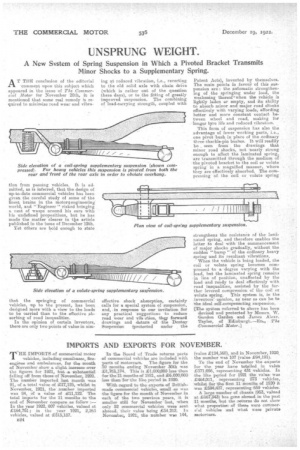UNSPRUNG WEIGHT.
Page 10

If you've noticed an error in this article please click here to report it so we can fix it.
A New System of Spring Suspension in Which a Pivoted Bracket Transmits Minor Shocks to a Supplementary Spring.
AT THE conclusion of the editorial -commept upon this subject which appeared in the issue of The Commercial Motor for November 28th, it is mentioned that some real remedy is required to minimize road wear and vibra
tion from passing vehicles. ft is admitted, as is inferred, that the design of up-to-date commercial vehicles has been given the careful study of some of the finest brains in the motoroengineering world, and "Engineer" risked bringing a nest of wasps around his ears with his undefined propositions, but he has made the matter clearer in ttie article published in the issue of December 12th.
Yet others are bold enough to state that the springing of commercial vehicles, up to the present, has been designed more with a view to the loads to be carried than to the effective Absorbing of road inequalities.
In the opinion of certain inventors, there are only two points of value in aim
ing at reduced vibration, i.e., reverting to the old solid axle with chain drive (which is rather out of the question these days), or to the fitting of greatly improved suspension. The combining of load-carrying strength, coupled with effective shock absorption, certainly calls for a special system of suspension, and, in response to our invitation for any practical suggestions to reduce road wear and vita ation, they forward drawings and detail of the Dentay Suspension (protected under the Patent Acts), invented by themselves. The main points in favour of this suspension are ; the Automatic strengthening of the springing under load, the weakening thereof 'when the vehicle is lightly laden or empty, and its ability to absorb minor and major road shocks effectively with varying loads, affording better and more constant contact between wheel and road, making for longer tyre life and reduced vibration.
This form of suspension has also the advantage of fewer working parts, i.e., one pivot bush in place of the ordinary three shackle-pin bushes. It will readily be _ seen from the drawings that minor road shocks, not "nearly strong enough to affect the laminated spring, are transmitted through the medium of the pivoted bracket to the coil or volute spring in a magnified manner, where they are effectively absorbed. ihe compressing of the coil or volute spring strengthens the resistance of the laminated spring, and therefore enables the latter to deal with the commencement of major shocks gradually, without the sudden " bump " of the ordinary heavy spring and its resultant vibra,tions. When the vehicle is being loaded, the coil Sr volute spring becomes compressed to a degree varying with the load, hut the laminated spring remains in line of position, unaffected by the load and ready to deal effectively with road inequalities, assisted by the further levered compression of the coil or volute spring. This system is, in the inventors' opinion, as near as can be to the ideal self-compensating suspension.
[The system referred to above has been devised and protected by Messrs. W. Gordon Garden and James Alexr. Taylor, of Eclinhurgh.—En., The Commercial Motor.]




























